Types of Galaxies
Despite the incredible number of galaxies, there is surprising consistency in their overall shapes. Edwin Hubble began cataloging their appearance in the 1920s. The Hubble classification of galaxies—spirals, barred spirals, lenticulars, ellipticals, irregulars, and their subclasses—is still used today.
16-1 The winding of a spiral galaxy’s arms is correlated to the size of its central bulge
Spiral galaxies without bars (often called normal spiral galaxies) are characterized by a central bulge and arched lanes of stars and interstellar clouds, which appear as arms that spiral out from the bulge. Observations of many spiral galaxies reveal that the more tightly wound the spiral, the larger the central bulge.
As shown in Figure 16-1, spirals with tightly wound spiral arms (and fat central bulges) are called Sa (for spiral type a) galaxies. Those with moderately wound spiral arms (and a moderate central bulge) are Sb galaxies. Loosely wound spirals (with small central bulges) are Sc galaxies. A typical spiral galaxy contains about 100 billion stars and measures nearly 105 light-years in diameter.
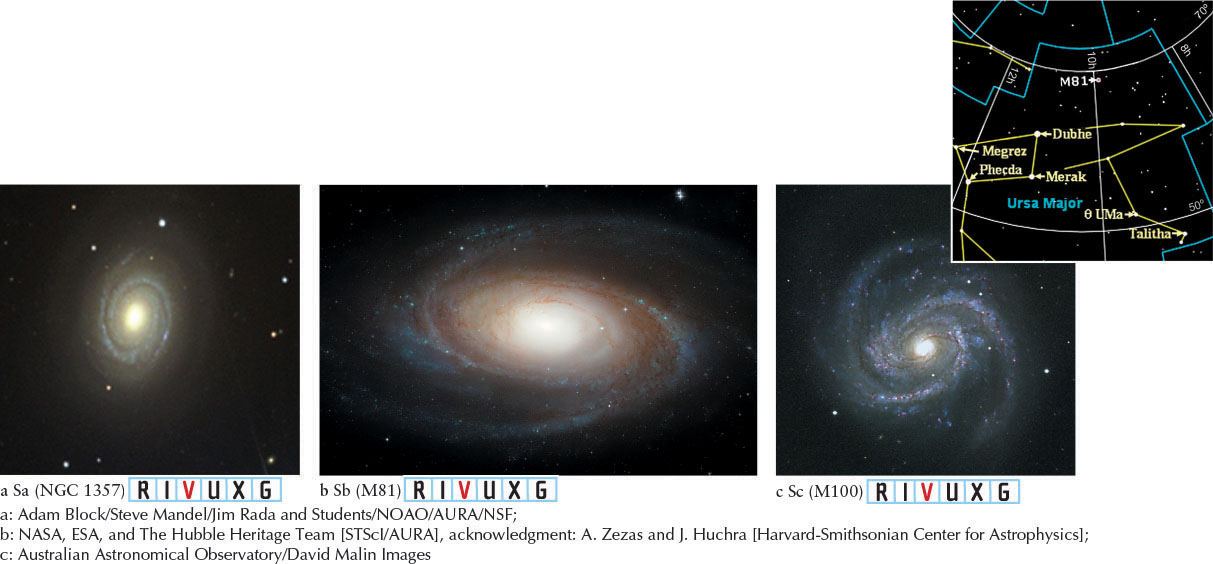
The closest spiral galaxy to the Milky Way is the Andromeda Galaxy, M31 (Figure 16-2). M31 is visible to the naked eye as a fuzzy blob in the constellation of Andromeda. Rather than being face-on or edge-on, the disk of this galaxy is tilted as seen from Earth, typical of many spiral galaxies. Some are tilted so much that their spiral arms are not evident. We can still classify these galaxies as specific spiral types by observing the sizes of their central bulges. For example, M104 (Figure 16-3a) has a huge central bulge. It must therefore be an Sa galaxy with tightly wound arms. An Sb galaxy (Figure 16-3b) has a smaller central bulge. The tiny central bulge of an Sc galaxy (Figure 16-3c) is hardly noticeable at all in an edge-on view.
483
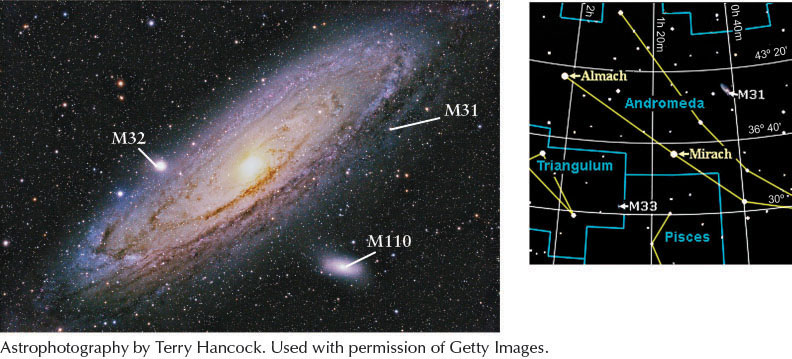
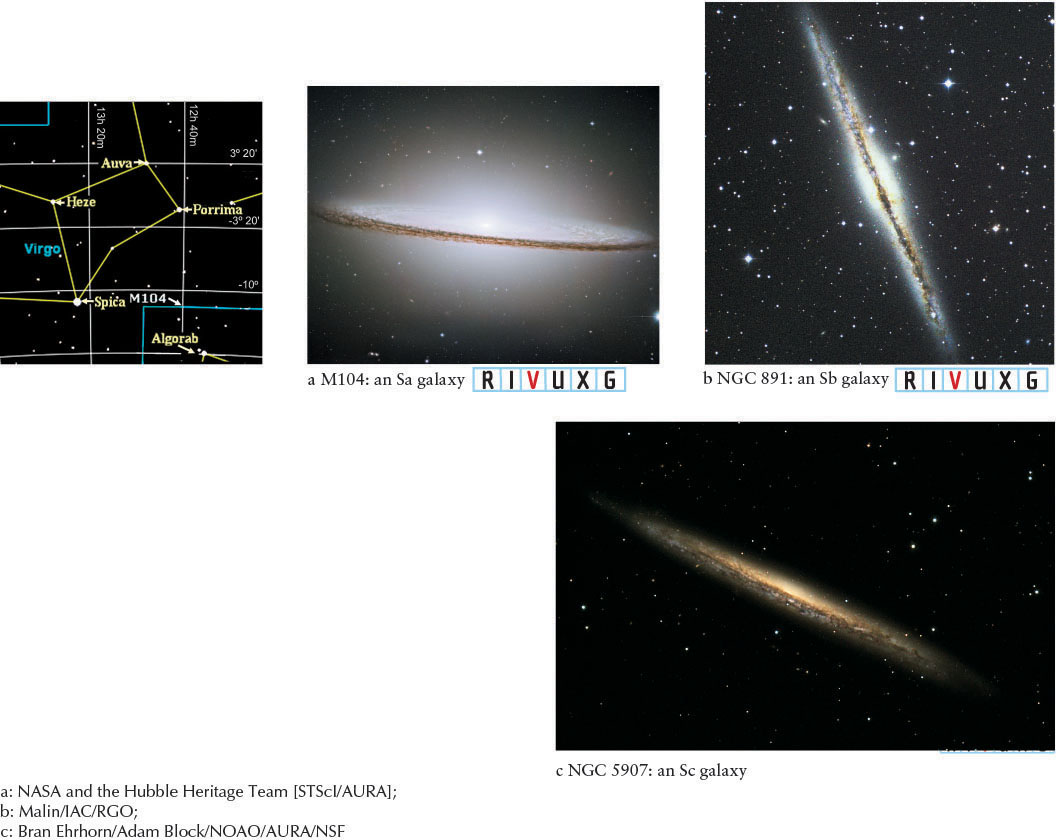
484
Besides the degree of winding, the overall appearance of individual spiral arms typically has one of two structures. In some galaxies, called flocculent spirals (from the word meaning “fleecy”), the spiral arms are broad, fuzzy, chaotic, and poorly defined (Figure 16-4a). Other galaxies, called grand-design spirals, exhibit beautiful arching arms outlined by brilliant H II regions and OB associations. In these galaxies, the spiral arms are thin, delicate, graceful, and well defined (Figure 16-4b).
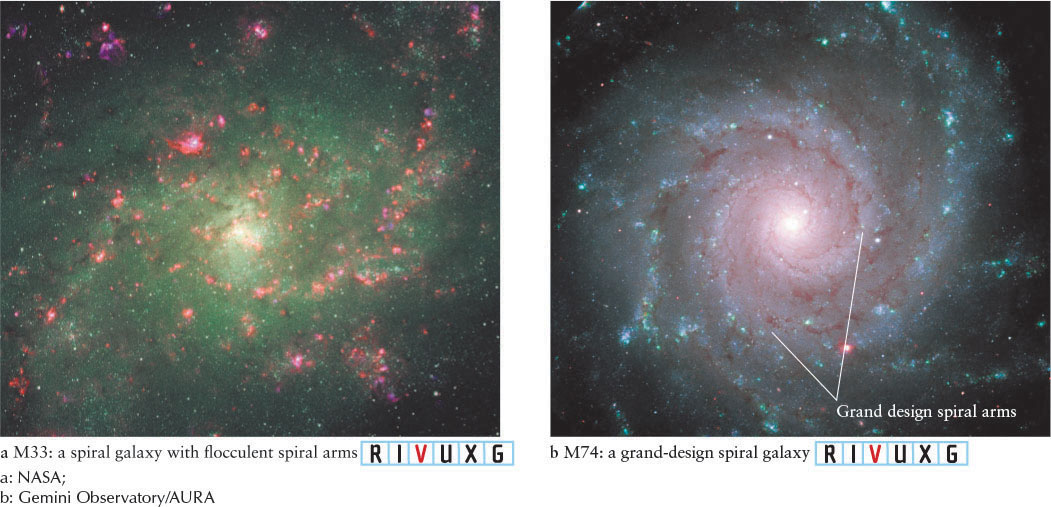
Margin Question 16-1
Question
Comparing it to the galaxies in Figure 16-1 or 16-3, what is the spiral classification of M74, shown in Figure 16-4b?
At first glance, it may seem that the shapes of spiral galaxies are created by the orbital motions of strings of stars, with the stars closer to the center of the galaxy orbiting more rapidly and thereby leading the outer edges of the spirals. But, in this case, common sense leads us astray. Although the stars closer to the center of the galaxy do orbit faster than those farther away, spiral arms cannot be orbiting strings of stars. If they were, the spiral arms should “wind up” from the inside out (Figure 16-5), wrapping themselves tightly around the nucleus. While this action would take too long for us to observe in a single galaxy, hundreds of thousands of spiral galaxies have been observed, and all are seen in just a few states of “winding” (see Figure 16-1), which is not consistent with this model.
Furthermore, if star motions caused spirals, then after a few galactic rotations, the spiral structure should disappear altogether. Why, then, do we observe spiral arms in our Galaxy and many others? This winding dilemma led astronomers to two explanations, one for flocculent spirals and the other for grand-design spirals.
16-2 Explosions create flocculent spirals, and waves create grand-design spirals
Flocculent Spiral Galaxies
Consider a disk galaxy so young that it has not yet formed spiral arms. Stars begin forming in one of its giant molecular clouds. The radiation and winds from these stars compress the nearby interstellar gas, triggering the formation of additional stars. Moreover, massive stars quickly explode as supernovae and produce shock waves, which further compresses surrounding gases until it is Jeans unstable (see Section 5-2). This gas collapses and forms new stars. Shock waves are very powerful compressions of the gas, like the sonic booms created by lightning, the snap of a whip, or a supersonic aircraft. Thus, as new stars trigger the birth of still other stars, the star-forming region grows, a process called self-propagating star formation.
The continuing birth of stars accounts for spiral arms in flocculent spiral galaxies. The galaxy’s differential rotation (inner regions orbit faster than outer regions; see Figure 16-5) drags the inner edge of each young region ahead of its outer edge, spreading the star-forming region into a spiral arm. This region of the galaxy is bright because it is highlighted by its brilliant O and B stars, and by the nebulae that these stars cause to glow. However, high-mass O and B stars explode relatively quickly, and each spiral arm dims before it winds up (that is, there is no winding dilemma here). As old arms fade, new star-forming regions appear and create new spiral arms.
485
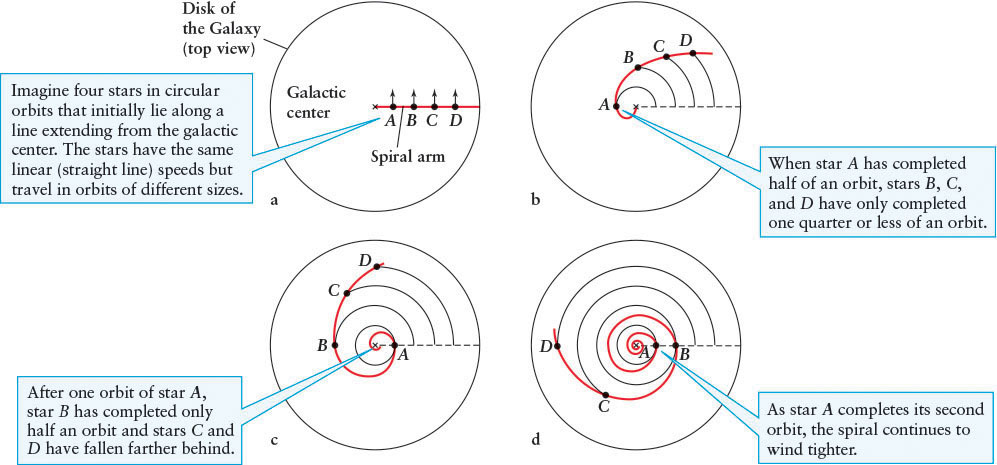
Where self-propagating star formation is the only process creating spiral arms in a galaxy, bits and pieces of these arms appear constantly, only to disappear as the bright, massive stars in them die. This process creates chaotic spiral arms, such as those observed in flocculent galaxies (see Figure 16-4a) but not the smooth spirals of grand-design galaxies. Thus, self-propagating star formation cannot be the whole story.
Grand-Design Spiral Galaxies
Our search for the mechanism that generates grand-design spirals begins in a pond. If you throw a rock into the water, you create ripples. As you know from experience, the ripples move outward in concentric rings from where the rock struck (Figure 16-6a). But suppose the pond water is rotating when you throw in a rock. Now what shape do the ripples have? According to calculations done by astronomer Bertil Lindblad (1895–1965) in the 1920s, ripples created in a rotating disk-shaped system of liquid (the pond) or gas and dust (a disk galaxy) will be spiral. These ripples are called spiral density waves.
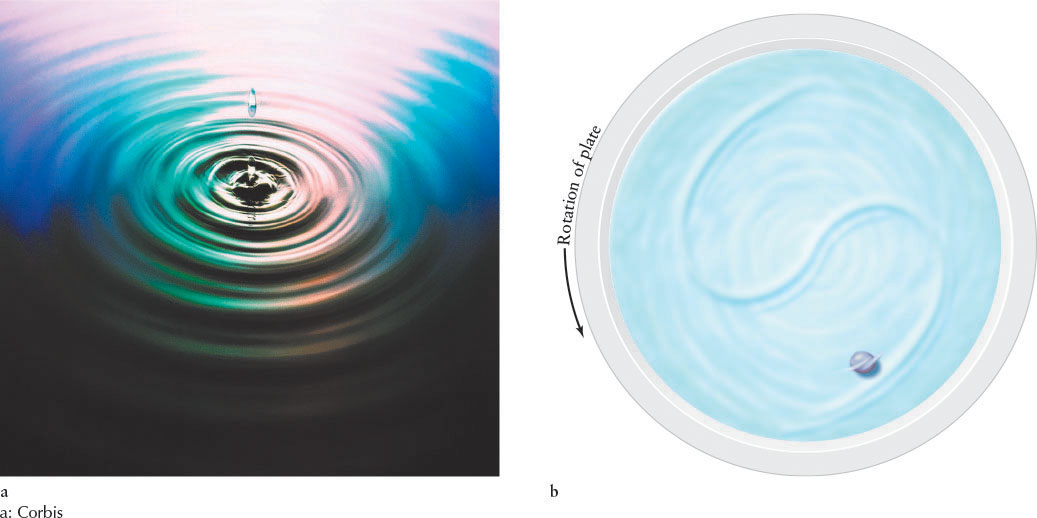
Russian scientists in the 1970s tested Lindblad’s model. Lacking the computer power to create simulations of galaxies, they threw pebbles into pie pans of water rotating on phonograph turntables. The resulting water wave patterns were indeed spirals, as drawn in Figure 16-6b. Furthermore, spiral density waves never wind up. In the case of the gas and dust in a galaxy, these waves orbit in a rigid spiral pattern at about half the average speed of the interstellar medium through which they move.
Margin Question 16-2
Question
Fill in the blanks: If analogous events occurred on Earth, we would call self-propagating star formation a _________ reaction or a _________ effect.
In the mid-1960s, two American astrophysicists looked carefully at how galactic spiral density waves traveling through the disk of a galaxy lead to spiral arms. C. C. Lin (1916–2013) and Frank Shu (1943–) argued that rigidly rotating spiral-shaped density waves cause interstellar gas and dust passing through them to temporarily pile up. This piling-up happens because, unlike water waves, which move up and down as they travel along, spiral density waves in the gas and dust of a galaxy are compressional waves, just like sound. As a result, they cause interstellar gas and dust to become compressed and, therefore, Jeans unstable as this material passes through the waves. The Jeans instabilities (see Section 5-2) lead to new star formation in the spiral density waves, creating spiral arms.
Lin and Shu demonstrated that a spiral arm is a galactic traffic jam. Imagine a slow-moving truck on a busy freeway. The cars normally cruise at 100 km/h (about 65 mi/h), but the truck causes a bottleneck. The cars slow down temporarily to avoid hitting other cars and the slowly moving truck. As seen from the air, there is a noticeable congestion of cars around the truck (Figure 16-7). An individual car spends only a few moments in the moving traffic jam before resuming its usual speed, but the traffic jam itself lasts all day long.
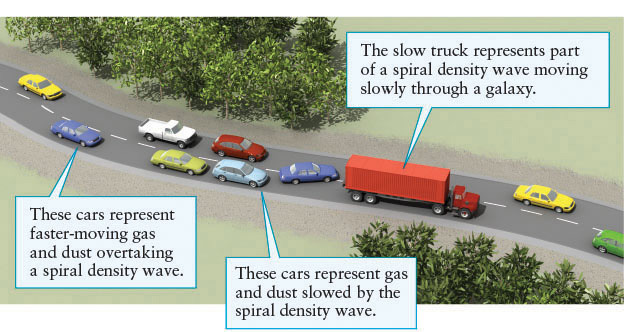
 Compression Wave in Traffic Flow When normal traffic flow is slowed down, cars bunch together. In a grand-design galaxy, a density wave moves through the stars and gas. The wave is merely a region of slightly denser matter, which, in turn, creates more gravitational force. This force compresses the gas and enhances star formation, which highlights the spiral density wave.
Compression Wave in Traffic Flow When normal traffic flow is slowed down, cars bunch together. In a grand-design galaxy, a density wave moves through the stars and gas. The wave is merely a region of slightly denser matter, which, in turn, creates more gravitational force. This force compresses the gas and enhances star formation, which highlights the spiral density wave.
486
The vehicles in the traffic jam represent interstellar gas and dust entering a spiral arm. The truck represents a small part of a spiral density wave. Like the cars catching up to and passing the truck, the metal-rich interstellar medium sweeps through the more slowly moving spiral density waves. The waves compress some of this interstellar gas and dust, which contract to form new, metal-rich stars. We see spiral arms because they contain bright O and B stars and copious quantities of dust and gas that these stars illuminate. The sprawling dust lanes in Figure 16-4b attest to the passage of that material through a spiral density wave. While all of this occurs, the density wave maintains its shape, and, overall, the spiral arms in these galaxies are better defined than in the flocculent galaxies discussed earlier.
 A few high-mass stars form in most open clusters, such as those created in spiral density waves. So why are spiral galaxies not eventually filled with enough of these bright stars to wash out the spiral arms and to make the disk uniformly bright? The answer is that the massive stars highlighting each density wave are short-lived and they explode before they finish passing through it. The remaining, longer-lived, lower-mass stars, like our Sun, fill the space between the spiral arms without emitting as much light (see Figure 16-4b). As pronounced as spiral arms may appear, they contain only 5% more stars than are found between them.
A few high-mass stars form in most open clusters, such as those created in spiral density waves. So why are spiral galaxies not eventually filled with enough of these bright stars to wash out the spiral arms and to make the disk uniformly bright? The answer is that the massive stars highlighting each density wave are short-lived and they explode before they finish passing through it. The remaining, longer-lived, lower-mass stars, like our Sun, fill the space between the spiral arms without emitting as much light (see Figure 16-4b). As pronounced as spiral arms may appear, they contain only 5% more stars than are found between them.
It takes an enormous amount of energy from the spiral density waves to compress interstellar gas and dust. After a billion years or so, even spiral density waves would begin to fade away. Some driving mechanisms must keep them going, akin to throwing more rocks in the pond to maintain its ripples. We are not yet completely certain what those mechanisms are, but one likely explanation for reinvigorating the galactic spiral structure is the passage of a nearby companion galaxy. As this nearby galaxy periodically passes close by, its gravitational attraction pulls on the gas, stars, and dust of the spiral galaxy and causes this latter galaxy to generate new density waves. Indeed, grand-design galaxies are usually found in the presence of a companion galaxy.
487
Although most spiral galaxies have two arms, a sizable minority has more. Astronomers have not yet established why the numbers of arms vary.
Because new stars are formed from interstellar gas and dust, it is plausible that galaxies with different amounts of this material will have different star formation rates and therefore different overall structures. Infrared and radio observations reveal that Sa galaxies typically contain about 4% gas and dust, whereas Sb galaxies contain 8%, and Sc galaxies contain 25%. Continually improving computer simulations of galaxies reveal more and more of the details of how various concentrations of gas and dust affect galactic structure. Figure 16-8 summarizes the activity in a spiral galaxy.
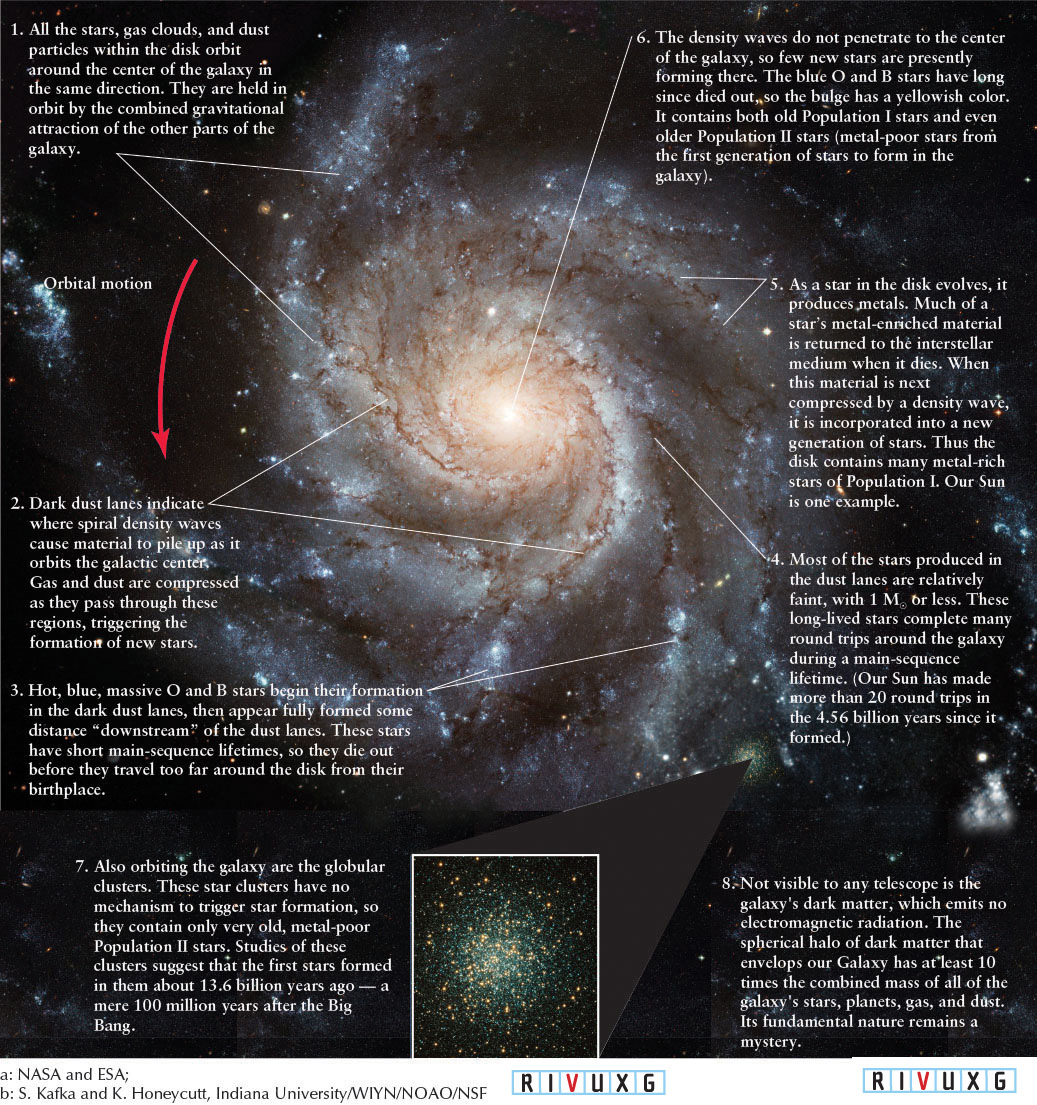
488
16-3 Bars of stars run through the central bulges of barred spiral galaxies, and some disk galaxies, the lenticulars, lack spiral arms
The Milky Way is a barred spiral galaxy, a spiral galaxy with a bar of stars and gas crossing through the central bulge. Bars form in some disk galaxies when stars near the centers of these galaxies that were originally following circular paths are pulled into more elliptical orbits. When enough stars are in highly elliptical orbits, they create the bars in barred spiral galaxies. These stars then gravitationally attract gas into the same orbits. Some of this gas is channeled toward the supermassive black holes residing in the centers of most, if not all, spiral galaxies.
Observations reveal that about 70% of nearby spiral galaxies have bars, while only 20% of more distant spiral galaxies do. The farther away that we see things, the longer the light from them has been traveling toward us. Since light travels at a finite speed, this means that the farther objects are from Earth, the farther back in time we are seeing them. The fact that fewer of the more distant galaxies have bars indicates that the number of barred spiral galaxies is increasing.
Margin Question 16-3
Question
Why do you think that spiral arms do not extend farther inward than the bar in barred spiral galaxies?
Taking all observed spirals into account, about one-third of them are barred spirals, the remainder being the normal spirals. The two main arms in barred spirals typically extend from the ends of the bar rather than from the central bulge itself. The largest known spiral galaxy is a barred spiral, NGC 6872, which is 522,000 ly across, more than 5 times the size of the Milky Way.
Edwin Hubble found that the winding of the spiral arms in barred spirals also correlates with the size of the central bulge (Figure 16-9), just as for normal spirals. An SBa (for spiral, barred, type a) galaxy has a large central bulge (and tightly wound spiral arms). Likewise, a barred spiral with moderately wound spiral arms (and a moderate central bulge) is an SBb galaxy, and an SBc galaxy has loosely wound spiral arms (and a tiny central bulge). The Milky Way is classified as an SBab. This indicates that the winding of its arms is between those of an SBa and an SBb. Sa and SBa are sometimes called early type galaxies, while Sc and SBc are called late type galaxies.
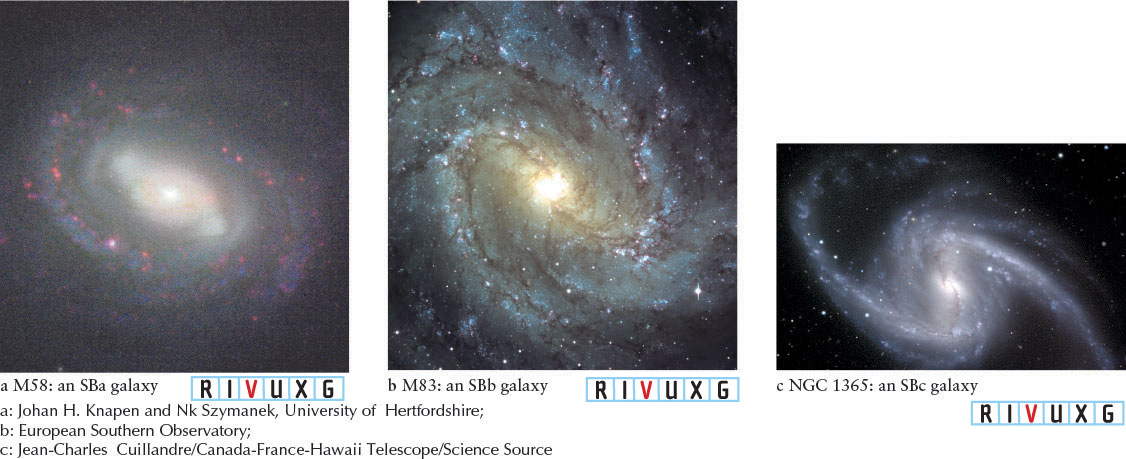
The motions of the stars in many nearby galaxies have been measured from Doppler shifts of their spectra. In all spiral and barred spiral galaxies discovered to date, except one, the arms trail around behind as the galaxies rotate. These galaxies are thus called trailing-arm spiral galaxies. The exception is the galaxy NGC 4622. This galaxy has the points of its spirals leading the motion of the arms. It is a leading-arm spiral. Calculations predict that the leading arms are unstable and that this galaxy will eventually switch and become a trailing-arm spiral.
A few disk galaxies, both unbarred and barred, lack spiral arms. These are classified as lenticular galaxies, because they look like lenses. Unbarred lenticulars are labeled S0, while barred lenticulars are denoted SB0.
16-4 Elliptical galaxies display a wide variety of sizes and masses
 Elliptical galaxies, named for their distinctive shapes, have no spiral arms. They range tremendously in size and mass—from the biggest to the smallest galaxies in the universe. Figure 16-10 includes two giant elliptical galaxies, M84 and M86, that form part of a cluster of galaxies in the constellation Virgo. These enormous giant elliptical galaxies are each about 2 million light-years in diameter, 20 times the diameter of the Milky Way Galaxy.
Elliptical galaxies, named for their distinctive shapes, have no spiral arms. They range tremendously in size and mass—from the biggest to the smallest galaxies in the universe. Figure 16-10 includes two giant elliptical galaxies, M84 and M86, that form part of a cluster of galaxies in the constellation Virgo. These enormous giant elliptical galaxies are each about 2 million light-years in diameter, 20 times the diameter of the Milky Way Galaxy.
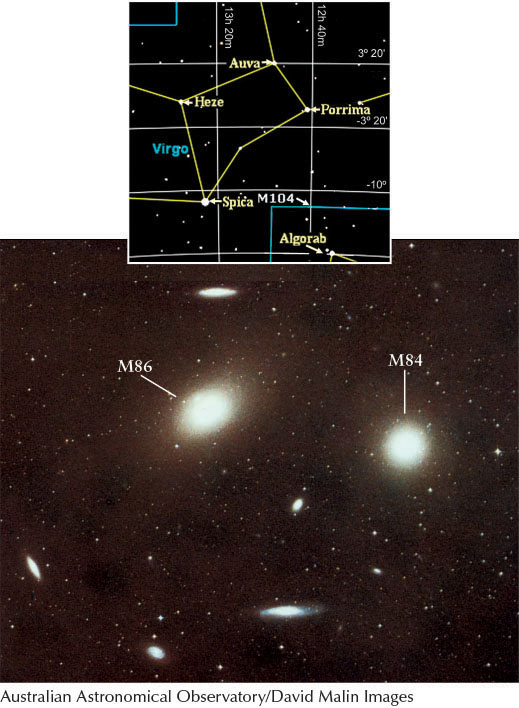
489
Giant ellipticals, containing some 10 trillion solar masses, are rare compared to other types of galaxies, whereas dwarf elliptical galaxies are extremely common. Dwarf ellipticals are only a fraction of the size of an average elliptical galaxy and contain so few stars—only a few million—that we see these galaxies as nearly transparent. Because you can actually see straight through the center of a dwarf elliptical galaxy and out the other side (Figure 16-11), distant ones are hard to detect. In 1999 astronomers discovered the existence of dwarf galaxies that are much more compact and have stars orbiting much closer together than traditional dwarf elliptical galaxies. Whereas traditional dwarf elliptical galaxies are a few thousand light-years in diameter, ultra compact dwarfs are a few hundred light-years across. Ultra compact dwarfs represent groups of stars intermediate in size and number between globular clusters (see Section 12-14) and traditional dwarf galaxies. Many more dwarf and ultra dwarf ellipticals undoubtedly exist than have been identified, and the uncertainty in their numbers is a major reason that we do not know the total number of galaxies in the visible universe.

Hubble subdivided elliptical galaxies according to how round or oval they look. The roundest elliptical galaxies are called E0 galaxies, whereas the most elongated are E7 galaxies. These latter are about 3 times longer than they are wide. Elliptical galaxies of intermediate elongation are numbered E1 to E6 (Figure 16-12).
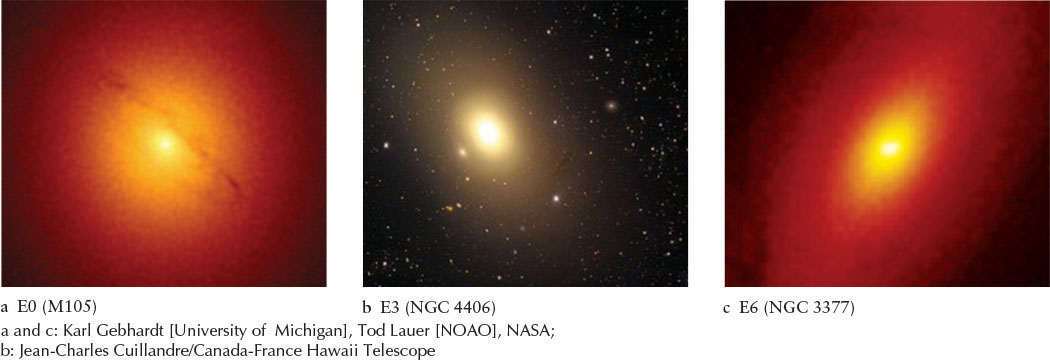
The Hubble scheme classifies galaxies solely by their appearance from Earth. But whenever we observe anything in the sky, we are seeing a two-dimensional view of a three-dimensional object. In the case of elliptical galaxies, we observe length and width, but we have no way of knowing anything about the third dimension of depth. What looks like an E0 galaxy (basically circular) might actually be egg-shaped when viewed from another angle. Conversely, an elongated E7 galaxy might look circular when viewed down its long axis.
490
Margin Question 16-4
Question
Instead of being classified an E0, what other classification could M105 in Figure 16-12a possibly have?
Elliptical galaxies look far less dramatic than their spiral and barred spiral cousins because they contain relatively little interstellar gas and dust. For example, the only gas visible in M105 (Figure 16-12a), is the dark line running from upper left to lower right. All the orange images are stars. Because stars form in interstellar clouds, relatively few stars should be forming in ellipticals compared to the numbers forming in spirals. Observations of spectra confirm the hypothesis that elliptical galaxies contain primarily Population II, low-mass, long-lived stars. However, billions of years ago, many ellipticals contained bright, massive stars that have since exploded as supernovae. We know this because the Chandra X-ray Observatory has discovered large numbers of remnant black holes and neutron stars in several of these galaxies.
16-5 Galaxies without global structure are called irregular
Edwin Hubble found some galaxies that cannot be classified as spirals, barred spirals, lenticulars, or ellipticals. He called these irregular galaxies. They are generally rich in interstellar gas, dust, and both young and old stars. Irregular galaxies with numerous OB associations and only hints of organized structure are denoted Irr I. The nearby Large Magellanic Cloud (LMC) (Figure 16-13a) and the Small Magellanic Cloud (SMC) are examples of Irr I galaxies. (Although they are among the closest galaxies to us, neither of them orbits the Milky Way.) Both can be seen with the naked eye from southern latitudes.

491
Occasionally, irregulars are observed that appear highly distorted and completely asymmetrical, as though created by collisions between galaxies or by violent activity in their nuclei. These galaxies are denoted Irr II, as shown by NGC 4485 (Figure 16-13b). Irregular galaxies are typically smaller and less massive than spirals, containing between about 108 and 3 × 1010 M⊙.
16-6 Hubble presented spiral and elliptical galaxies in a tuning fork-shaped diagram
Edwin Hubble connected the four regularly shaped types of galaxies—spirals, barred spirals, lenticulars, and ellipticals—in a diagram shaped like a tuning fork (Figure 16-14). For want of any better scheme, the irregular galaxies are sometimes placed between the ends of the tuning fork prongs of the Hubble diagram.
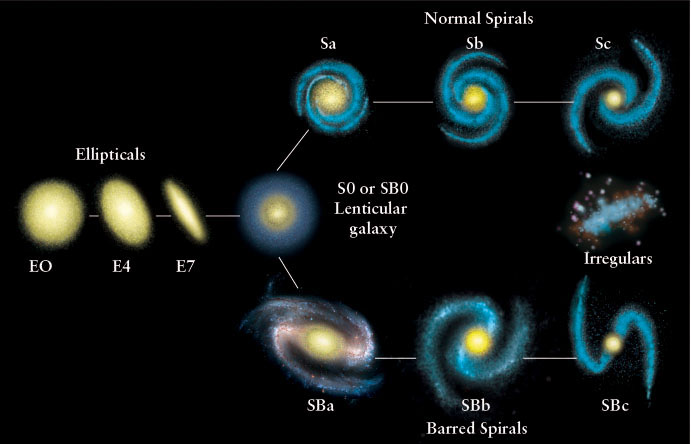
Although Hubble did not intend it when he designed his tuning fork diagram, the idea that one type of galaxy may change into another type has been in and out of favor with astronomers for decades. As we will see later in this chapter and in Chapter 18, extensive observations by the Hubble Space Telescope and by ground-based telescopes reveal that interactions between galaxies sometimes do lead to changes in their structures. For example, when two disk galaxies merge, they often morph into a giant elliptical galaxy. Once formed, about three-quarters of all galaxies have maintained their structures, whereas the remaining quarter have changed (for example, from spiral to elliptical). The properties of the different types of galaxies are summarized in Table 16-1.
| Spiral (S) and barred spiral (SB) galaxies | Elliptical galaxies (E) | Irregular galaxies (Irr) | |
|---|---|---|---|
| Mass (M⊙) | 109 to 4 × 1011 | 107 to 1013 | 108 to 3 × 1010 |
| Luminosity (L⊙) | 108 to 2 × 1010 | 3 × 105 to 1011 | 107 to 109 |
| Diameter (ly) | 1.6 × 104 to 8 × 105 | 3 × 103 to 6.5 × 105 | 3 × 103 to 3 × 104 |
| Stellar populations | Disk: young Population I central bulge; halo: Population II and old Population I | Population II and old Population I | Mostly Population I |
| Percentage of observed galaxies | 77% | *20% | 3% |
| *This percentage does not include dwarf elliptical galaxies that are as yet too dim and distant to detect. Hence, the actual percentage of galaxies that are ellipticals is likely to be higher than shown here. | |||
Margin Question 16-5
Question
The Large Magellanic Cloud is visible to the naked eye in the southern hemisphere. From Figure 16-13a, what terrestrial things do you think it could be mistaken for?
16-7 Galaxies built up in size over time
In Chapter 18, we will explore the observational evidence for the formation and early evolution of galaxies. Nevertheless, it is worth summarizing here what astronomers know about why the galaxies have the structures we observe. With the exception of dwarf ellipticals, galaxies formed from smaller ensembles of stars, gas, and dust. The underlying dark matter that clumped together in the young universe drew this matter together, often assisted by supermassive black holes that formed early in the life of the universe. These black holes became the nuclei of the galaxies. The more massive the black hole, the larger a disk galaxy’s central bulge. Recent observations show that it often took several billion years for disk galaxies to accumulate most of their gas and settle down into the stable star-forming systems we see today.
492
Normal (unbarred) spiral galaxies formed when swirling eddies of gas-rich matter collided and formed a disk centered on an especially massive black hole and lots of dark matter. When the amount of dark matter and the mass of the central black hole were too low, the matter in the central regions of the disk had bar-shaped orbits, creating the early barred spiral galaxies.
When the collision of galaxy-forming gases led to especially rapid star formation, the resulting galaxies were elliptical or irregular. Giant elliptical galaxies were (and still are) formed from the collisions of two spiral galaxies (of any type).
Margin Question 16-6
Question
What physical property of matter discussed in Chapter 2, besides gravitation, is essential in forming all spiral galaxies?
Galaxy collisions do not just occur in pairs. Stephan’s quintet, discovered in 1877 by the French astronomer Edouard Stephan (1837–1923), is a group of five galaxies bound together. Four of its members are undergoing multiple collisions with each other. They will eventually merge to form a single giant elliptical galaxy. This is not a unique interaction: In 2002, the Hubble Space Telescope observed four galaxies colliding simultaneously.